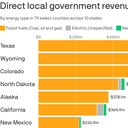The trouble with replacing fossil fuel revenue

It will take far more than renewables growth to sustain communities facing local revenue loss if strong climate policies curtail fossil fuel production and use.
Driving the news: New research from Resources For the Future and the University of Michigan explores how different forms of energy provide revenues in 79 counties across 10 states.
Why it matters: Limiting climate change will require moving away from fossil fuels. Yet they provide vital tax revenue and other money streams for services like schools, roads, and safety.
The intrigue: Wind and solar increasingly do too — with more to come as they grow. But these things often aren't fungible.
- "[T]he geographically dispersed nature of wind and solar means that these alternatives would need to cover implausibly large portions of fossil fuel–dependent counties to replace the revenues they currently generate," the working paper states.
The big picture: In areas with rather low fossil revenue dependence, wind and solar are a viable replacement, the study's authors note.
- But for highly fossil-reliant areas, state or federal support for essential services is needed "under any deep decarbonization scenario." These areas also need "new economic drivers."
Catch up fast: Various policies already aim to help areas facing energy transition.
- For instance, the 2022 climate law provides extra tax incentives for "clean" projects in "energy communities."
Yes, but: Lead author Daniel Raimi of RFF tells me programs through the 2021 infrastructure law, 2022 climate law, and executive moves are helpful but insufficient for several reasons.
- One is that they're rather coal-focused, while oil and gas are a much larger public revenue source.
Zoom in: The U.S. remains highly reliant on fossil fuels — especially oil and gas — so those revenues are currently much larger.
- Fossil fuels generated over $10,000 per capita in government revenue in six counties analyzed, and over $1,000 in 28.
- The highest amount of per-capita revenue from wind and solar was around $1,000 — and only 11 counties were above $100, the paper finds.
- Fossil fuels account for more than half of property tax revenues in 15 counties and more than 10% in 47 counties.
The bottom line: "This is a whale of an issue — and we've just got a handle on the fin," Raimi said in a statement.